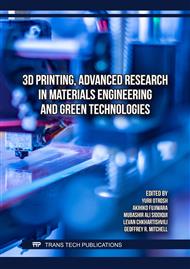[1]
Hansen, Charles M. "The three dimensional solubility parameter." Danish Technical: Copenhagen 14 (1967).
Google Scholar
[2]
Lee, Sumin, et al. "Novel solubility prediction models: Molecular fingerprints and physicochemical features vs graph convolutional neural networks." ACS omega 7.14 (2022): 12268-12277.
DOI: 10.1021/acsomega.2c00697
Google Scholar
[3]
Belmares, M., et al. "Hildebrand and Hansen solubility parameters from molecular dynamics with applications to electronic nose polymer sensors." Journal of computational chemistry 25.15 (2004): 1814-1826.
DOI: 10.1002/jcc.20098
Google Scholar
[4]
Hildebrand, J. H., and R. L. Scott. "The Solubility of Non-Electrolytes, Reinhold, New York." (1950).
Google Scholar
[5]
Ahmed, Darya Rasul, and Fahmi F. Muhammadsharif. "A Review of Machine Learning in Organic Solar Cells." (2024).
Google Scholar
[6]
Wu, Xiaotong, et al. "Machine learning in the identification, prediction and exploration of environmental toxicology: Challenges and perspectives." Journal of Hazardous Materials 438 (2022): 129487.
DOI: 10.1016/j.jhazmat.2022.129487
Google Scholar
[7]
He, Lei, et al. "Applications of computational chemistry, artificial intelligence, and machine learning in aquatic chemistry research." Chemical Engineering Journal 426 (2021): 131810.
DOI: 10.1016/j.cej.2021.131810
Google Scholar
[8]
Hastings, Janna, et al. "Learning chemistry: exploring the suitability of machine learning for the task of structure-based chemical ontology classification." Journal of Cheminformatics 13 (2021): 1-20.
DOI: 10.1186/s13321-021-00500-8
Google Scholar
[9]
Terrell, Evan. "Estimation of Hansen solubility parameters with regularized regression for biomass conversion products: An application of adaptable group contribution." Chemical Engineering Science 248 (2022): 117184.
DOI: 10.1016/j.ces.2021.117184
Google Scholar
[10]
AlQasas, Neveen, and Daniel Johnson. "The use of neural network modeling for the estimation of the Hansen solubility parameters of polymer films from contact angle measurements." Surfaces and Interfaces 44 (2024): 103721.
DOI: 10.1016/j.surfin.2023.103721
Google Scholar
[11]
Chi, Mingzhe, et al. "Atomistic descriptors for machine learning models of solubility parameters for small molecules and polymers." Polymers 14.1 (2021): 26.
DOI: 10.3390/polym14010026
Google Scholar
[12]
Lee, Min-Hsuan. "Interpretable machine-learning for predicting power conversion efficiency of non-halogenated green solvent-processed organic solar cells based on Hansen solubility parameters and molecular weights of polymers." Solar Energy 261 (2023): 7-13.
DOI: 10.1016/j.solener.2023.05.050
Google Scholar
[13]
Li, Chunrong, et al. "Machine learning approach to predict Hansen solubility parameters of cocrystal coformers via integrating group contribution and COSMO-RS." Journal of Molecular Liquids (2024): 125319.
DOI: 10.1016/j.molliq.2024.125319
Google Scholar
[14]
Wigh, Daniel S., Jonathan M. Goodman, and Alexei A. Lapkin. "A review of molecular representation in the age of machine learning." Wiley Interdisciplinary Reviews: Computational Molecular Science 12.5 (2022): e1603.
DOI: 10.1002/wcms.1603
Google Scholar
[15]
Pang, Jiayun, Alexander WR Pine, and Abdulai Sulemana. "Using natural language processing (NLP)-inspired molecular embedding approach to predict Hansen solubility parameters." Digital Discovery 3.1 (2024): 145-154.
DOI: 10.1039/d3dd00119a
Google Scholar
[16]
Choi, Phillip, Tom A. Kavassalis, and Alfred Rudin. "Estimation of the three-dimensional solubility parameters of alkyl phenol ethoxylates using molecular dynamics." Journal of colloid and interface science 150.2 (1992): 386-393
DOI: 10.1016/0021-9797(92)90208-4
Google Scholar
[17]
Panayiotou, Costas. "Solubility parameter revisited: an equation-of-state approach for its estimation." Fluid Phase Equilibria 131.1-2 (1997): 21-35
DOI: 10.1016/s0378-3812(96)03221-9
Google Scholar
[18]
Perea, J. Darío, et al. "Combined computational approach based on density functional theory and artificial neural networks for predicting the solubility parameters of fullerenes." The Journal of Physical Chemistry B 120.19 (2016): 4431-4438.
DOI: 10.1021/acs.jpcb.6b00787
Google Scholar
[19]
Sanchez‐Lengeling, Benjamin, et al. "A Bayesian approach to predict solubility parameters." Advanced Theory and Simulations 2.1 (2019): 1800069.
Google Scholar
[20]
Cvetković, Darja, et al. "Enhancing Hansen Solubility Predictions with Molecular and Graph-Based Approaches." Chemometrics and Intelligent Laboratory Systems (2024): 105168.
DOI: 10.1016/j.chemolab.2024.105168
Google Scholar
[21]
Pang, Jiayun, Alexander WR Pine, and Abdulai Sulemana. "Using natural language processing (NLP)-inspired molecular embedding approach to predict Hansen solubility parameters." Digital Discovery 3.1 (2024): 145-154.
DOI: 10.1039/d3dd00119a
Google Scholar
[22]
Li, Chunrong, et al. "Machine learning approach to predict Hansen solubility parameters of cocrystal coformers via integrating group contribution and COSMO-RS." Journal of Molecular Liquids (2024): 125319.
DOI: 10.1016/j.molliq.2024.125319
Google Scholar
[23]
Saini, Vaneet. "Machine learning prediction of empirical polarity using SMILES encoding of organic solvents." Molecular diversity 27.5 (2023): 2331-2343.
DOI: 10.1007/s11030-022-10559-6
Google Scholar
[24]
Abbott, Steven. "Solubility science: principles and practice." University of Leeds: Leeds, UK (2017): 109-110.
Google Scholar
[25]
Chen, T. & Guestrin, C. (2016). XGBoost: A Scalable Tree Boosting System. Proceedings of the 22nd ACM SIGKDD International Conference on Knowledge Discovery and Data Mining.
DOI: 10.1145/2939672.2939785
Google Scholar
[26]
Dorogush, A.V., Ershov, V. & Gulin, A. (2018). CatBoost: gradient boosting with categorical features support. arXiv:1810.11363.
Google Scholar
[27]
Ke, G. et al. (2017). LightGBM: A Highly Efficient Gradient Boosting Decision Tree. Advances in Neural Information Processing Systems.
Google Scholar
[28]
Dietterich, T.G. (2000). Ensemble methods in machine learning. Multiple Classifier Systems.
Google Scholar
[29]
Akiba, T. et al. (2019). Optuna: A Next-generation Hyperparameter Optimization Framework. Proceedings of the 25th ACM SIGKDD International Conference on Knowledge Discovery & Data Mining.
DOI: 10.1145/3292500.3330701
Google Scholar
[30]
RDKit: Open-source cheminformatics. https://www.rdkit.org
Google Scholar
[31]
Moriwaki H, Tian Y-S, Kawashita N, Takagi T (2018) Mordred: a molecular descriptor calculator. Journal of Cheminformatics 10:4
DOI: 10.1186/s13321-018-0258-y
Google Scholar
[32]
Rofik, Rofik, and Nurul Hidayat. "Improving the Accuracy of the Logistic Regression Algorithm Model using SelectKBest in Customer Prediction Based on Purchasing Behavior Patterns." Future Computer Science Journal 1.1 (2023): 9-17.
Google Scholar


